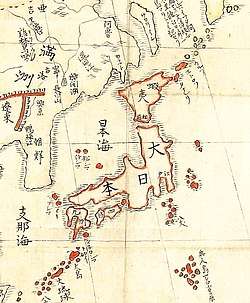Tenpyō-shōhō
Tenpyō-shōhō (天平勝宝) was a Japanese era name (年号,, nengō,, lit. "year name") after Tenpyō-kanpō and before Tenpyō-hōji. This period spanned the years from July 749 through August 757.[1] The reigning emperor was Kōken-tennō (孝謙天皇).[2]
| History of Japan |
|---|
 |
Change of era
- 749 Tenpyō-shōhō gannen (天平勝宝元年): The new era name of Tenpyō-shōhō (meaning "Heavenly Peace and Victorious Treasure")[3] was created to mark the accession of Empress Kōken. Shortly after Tenpyō-kanpō was initially proclaimed, Shōmu renounced the throne, thus becoming the first emperor to take the tonsure as a Buddhist monk.[4] Shōmu's reign and the Tenpyō-kanpō era ended simultaneously as he began a new phase of his life. The previous era ended after a mere four months, and the new one commenced in Tenpyō-kanpō 1, on the 2nd day of the 7th month of 749.[5]
Events of the Tenpyō-shōhō era
- 749 (Tenpyō-shōhō 1): Emperor Shōmu abdicates, and his daughter receives the succession (senso). Shortly thereafter, Empress Kōken formally accedes to the throne (sokui).[6]
- 749 (Tenpyō-shōhō 1)
- 752 (Tenpyō-shōhō 4, 4th month): The Eye-Opening Ceremony celebrating the completion of the Great Buddha is held at Tōdai-ji in Nara.[7]
- 5 September 750 (Tenpyō-shōhō 2, 1st day of the 8th month): In the 10th year of Kōken-tennō 's reign (称徳天皇10年), the empress abdicated; and succession (senso) was received by her adopted son. Shortly thereafter, Emperor Junnin is said to have acceded to the throne (sokui).[8]
Notes
- Nussbaum, Louis-Frédéric. (2005). "Tenpyō-shōhō" in Japan Encyclopedia, p. 957, p. 957, at Google Books; n.b., Louis-Frédéric is pseudonym of Louis-Frédéric Nussbaum, see Deutsche Nationalbibliothek Authority File Archived 2012-05-24 at Archive.today.
- Titsingh, Isaac. (1834). Annales des empereurs du Japon, pp. 73-75; Varley, Paul. (1980). Jinnō Shōtōki, pp. 143-144.
- Bowman, John. (2000). Columbia Chronologies of Asian History and Culture, p. 127.
- Varley, p. 143.
- Brown, p. 274.
- Varley, p. 44; a distinct act of senso is unrecognized prior to Emperor Tenji; and all sovereigns except Jitō, Yōzei, Go-Toba, and Fushimi have senso and sokui in the same year until the reign of Emperor Go-Murakami.
- Titsingh, p. 74.
- Titsingh, p. 75; Brown, p. 275; Varley, p. 44, 144.
gollark: Wow. Amazing.
gollark: --achieve test
gollark: --help achieve
gollark: --achievement test
gollark: Wondrous!
References
- Bowman, John Stewart. (2000). Columbia Chronologies of Asian History and Culture. New York: Columbia University Press. ISBN 9780231110051; ISBN 9780231110044; OCLC 42429361
- Brown, Delmer M. and Ichirō Ishida, eds. (1979). Gukanshō: The Future and the Past. Berkeley: University of California Press. ISBN 978-0-520-03460-0; OCLC 251325323
- Nussbaum, Louis-Frédéric and Käthe Roth. (2005). Japan encyclopedia. Cambridge: Harvard University Press. ISBN 978-0-674-01753-5; OCLC 58053128
- Titsingh, Isaac. (1834). Nihon Odai Ichiran; ou, Annales des empereurs du Japon. Paris: Royal Asiatic Society, Oriental Translation Fund of Great Britain and Ireland. OCLC 5850691
- Varley, H. Paul. (1980). A Chronicle of Gods and Sovereigns: Jinnō Shōtōki of Kitabatake Chikafusa. New York: Columbia University Press. ISBN 9780231049405; OCLC 6042764
External links
- National Diet Library, "The Japanese Calendar" -- historical overview plus illustrative images from library's collection
| Preceded by Tenpyō-kanpō |
Era or nengō Tenpyō-shōhō 749–757 |
Succeeded by Tenpyō-hōji |
This article is issued from Wikipedia. The text is licensed under Creative Commons - Attribution - Sharealike. Additional terms may apply for the media files.